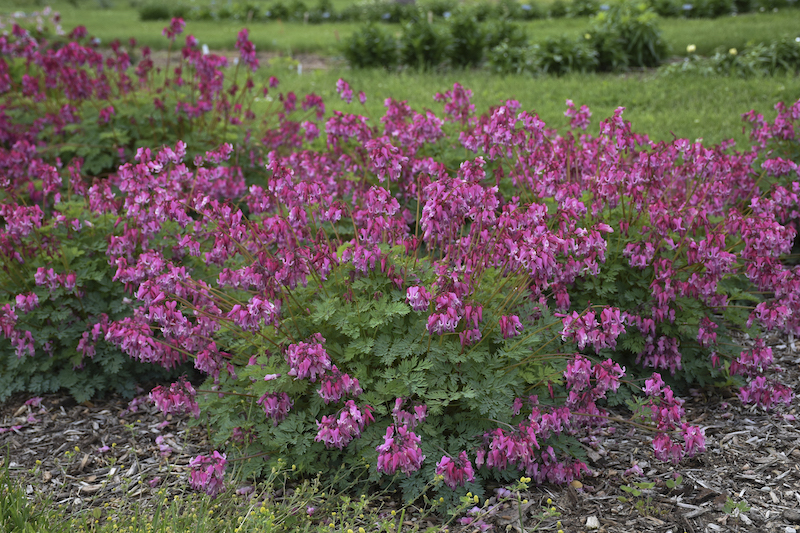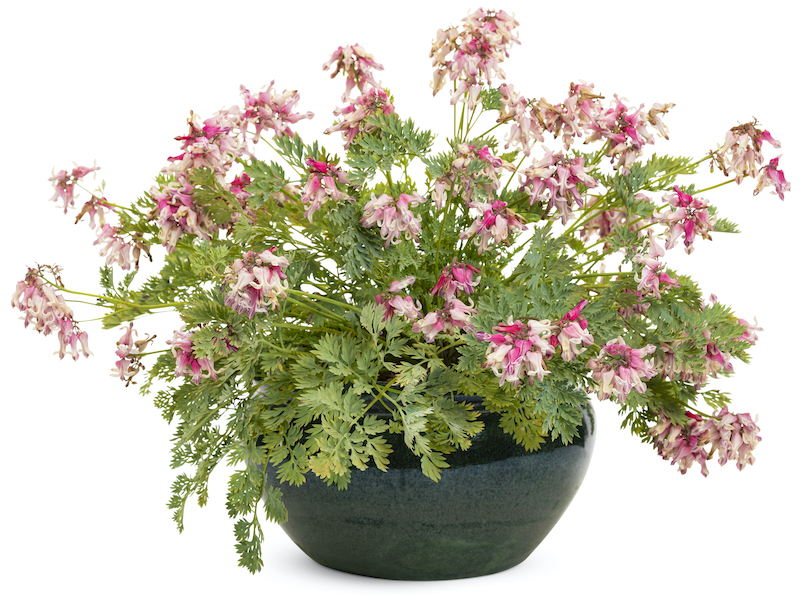Growing Bleeding Heart
As a quintessential early spring flower, Bleeding Heart (Dicentra spp.) emerges from the ground with its soft, feathery leaves and iconic heart-shaped blooms, ushering in a new year of growing and life. When these lovely plants bloom, you know warm spring weather is here to stay. These easy-to-care-for perennials can be found in many parts of the world, depending on the species, hailing from Southeast Asia to the Appalachian Mountains. The appearance of Bleeding Hearts leaves can vary as well, from the intricate and wispy leaves of the Fringed Bleeding Heart to the broad leaves of the Old Fashioned Bleeding Heart, with flowers that range from soft ballet slipper pink to buttery yellow to deep burgundy.

Bleeding Heart varieties can grow from 6 inches to 3 feet tall and tend to do best in light shade, especially in hotter and drier climates. With as little maintenance as regular watering to keep the soil moist, Bleeding Heart is a classic choice for shade and woodland gardens, especially because they tend to be deer and rabbit resistant. Once summertime temperatures are at their peak, Bleeding Heart leaves will yellow and die back, waiting patiently again for the arrival of the next spring.
Planting Bleeding Heart
Bleeding Heart should be planted in well-draining, rich, slightly acidic, moist soil. It is important that Bleeding Heart’s roots do not sit in standing water, as this may lead to root rot. While some varieties of Bleeding Heart can tolerate full sun, it is best to place these perennials in light shade, especially in hotter regions where their leaves can easily scorch from too much hot, direct sun. Morning sun is best for Bleeding Heart, and deep shade may prevent their beautiful blooms from flourishing.
To plant Bleeding Heart, dig a hole that is twice the width of the root ball. When backfilling the hole, do not bury the crown of the plant as this can lead to problems. Place 2-3 inches of mulch around the base of Bleeding Heart to help the soil retain moisture and keep the roots cool.

Watering Bleeding Heart
Bleeding Heart prefers consistently moist but not soggy soil. For this reason, water Bleeding Heart regularly, especially in warmer climates. Regular, deep watering is especially important through the first year that Bleeding Heart is in your garden. This will help the plant grow deep roots, aiding it in years to come. Once Bleeding Heart has gone dormant, it is not necessary to continue to water. When keeping Bleeding Heart in a pot, it may require more frequent water than when planted in the ground. Keep the soil moist and be sure to choose a pot that has adequate drainage.
Fertilizing Bleeding Heart
To set your Bleeding Heat up for success, plant it in rich, healthy soil amended with organic matter in the spring. Bleeding Heart is not a heavy feeder, and can often do just fine with a bit of compost added each year. If your soil quality is low, apply a slow-release perennial fertilizer in the spring to aid Bleeding Heart’s new growth and blooms. When a Bleeding Heart’s leaves yellow in the summer, it is normal and not related to nutrients; Bleeding Heart is going dormant and adding fertilizer will not return the leaves to green. When kept in pots, fertilize Bleeding Heart monthly using a liquid or slow-release fertilizer.
Pruning Bleeding Heart
Bleeding Heart does not require regular pruning, other than the removal of spent blooms. It is completely normal for the leaves of Bleeding Heart to turn yellow and die back as the heat of summer arrives. Similar to other early spring bloomers like Daffodils, it is a good idea to allow Bleeding Heart leaves to die back on their own, as removing them too early will prevent the plant from storing enough energy in its roots for the next spring’s growth. Once the leaves have completely yellowed and started to die, cut them back to the ground.
Caring For Bleeding Heart in Pots
Bleeding Heart is not an ideal choice for placement in pots, unless you are content with having an empty-looking pot for part of the year. You could also change them out for a different planting in the summer once they die back. When placing Bleeding Heart in a pot, be sure to choose a pot that is twice as large as the root ball. The pot must also have a drainage hole to prevent the roots from sitting in water. Choose a potting soil that is rich and well draining. In the winter, bring the pot into a protected area like an unheated garage to prevent any cold damage to the roots.

Winter Care for Bleeding Heart
Bleeding Heart will go dormant long before the arrival of winter. Beneath the soil, Bleeding Heart roots are quite cold tolerant, depending on the variety. In particularly cold regions, a thick layer of mulch can aid in protecting plant roots from temperature extremes. If planted in a pot, it is a good idea to bring Bleeding Heart into an unheated garage or basement, allowing the plant to stay dormant while also protecting its roots from extended freezes.
 |
Author Lynn Gusman - Published 3-17-2023 |
